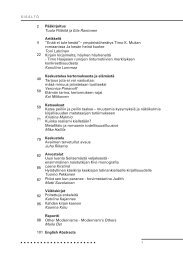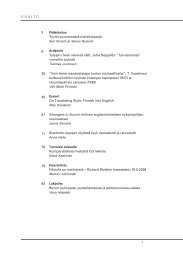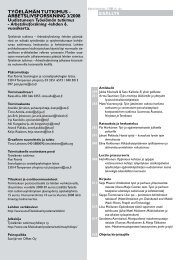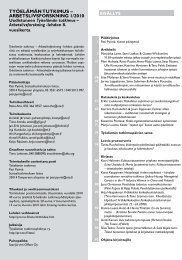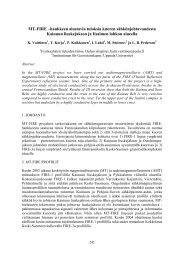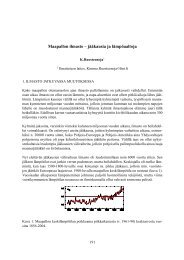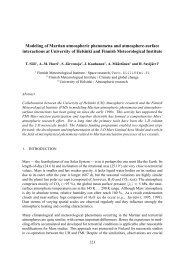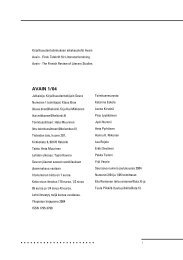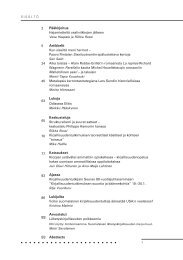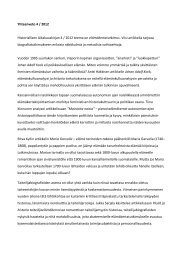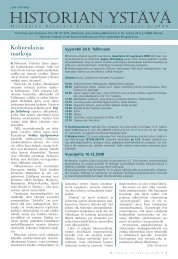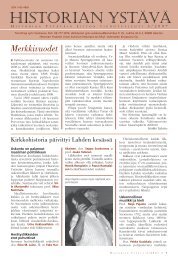De novis libris iudicia 271 nonché di qualche figura mitologica ...
De novis libris iudicia 271 nonché di qualche figura mitologica ...
De novis libris iudicia 271 nonché di qualche figura mitologica ...
You also want an ePaper? Increase the reach of your titles
YUMPU automatically turns print PDFs into web optimized ePapers that Google loves.
<strong>De</strong> <strong>novis</strong> <strong>libris</strong> <strong>iu<strong>di</strong>cia</strong> <strong>271</strong><br />
<strong>nonché</strong> <strong>di</strong> <strong>qualche</strong> <strong>figura</strong> <strong>mitologica</strong>. Alcune delle ostoteche sono iscritte, ma i testi vengono<br />
dati solo in maiuscolo e senza commento. Per esempio, il n. 18 (Museo <strong>di</strong> Adana, Tav. 54,<br />
3): ΛΟΥΝΙΣΔΙΣ/ΙΑΝΒΙΟΥΛΑ/ΜΟΤΗΣ, andrebbe letto così (con nell'ultima riga un'omega):<br />
Λουνις δὶς / Ἰανβίου Λα/μώτης (a meno che il nome del defunto sia λουνις, attestato<br />
almeno in Pisi<strong>di</strong>a). La documentazione fotografica delle ostoteche risulta esemplare.<br />
Nel bel libro <strong>di</strong> Işik ("Sarkophag-Stu<strong>di</strong>en" vol. 5), corredato da illustrazioni <strong>di</strong> alta<br />
qualità, sono raccolti 215 sarcofagi a ghirlanda, integri e frammentari, provenienti da Afro<strong>di</strong>sia<br />
e pubblicati prima del 1993 (si noti che il Nachwort dell'autore risale all'ormai lontano 1998).<br />
I materiali sono <strong>di</strong>visi in due tipi <strong>di</strong> sarcofagi, influenzati rispettivamente da modelli efesiaci<br />
("Ephesian-Aphro<strong>di</strong>sian") e urbani ("Roman-Aphro<strong>di</strong>sian"), entrambi a loro volta cronologicamente<br />
sud<strong>di</strong>visi in tre gruppi <strong>di</strong>stinti. Işik riesce a concludere che, col passare del tempo, la<br />
produzione locale dei sarcofagi <strong>di</strong>venne sempre più autonoma, tanto da giustificare l'esistenza<br />
<strong>di</strong> una serie <strong>di</strong> forme particolarmente tipiche <strong>di</strong> Afro<strong>di</strong>sia. Mentre in genere la <strong>di</strong>scussione<br />
risulta <strong>di</strong> un professionista qualificato, con ottima conoscenza <strong>di</strong> cambiamenti stilistici e <strong>di</strong><br />
tassonomie, avrebbero meritato più attenzione alcuni aspetti <strong>di</strong> carattere storico-religioso e archeologico,<br />
soprattutto i contesti socio-culturali in cui i sarcofagi venivano prodotti e poi successivamente<br />
esposti. Tali soggetti vengono <strong>di</strong>scussi nell'Appen<strong>di</strong>ce dei 44 sarcofagi iscritti,<br />
curata da Reynolds e Roueché, ma al lettore avrebbe maggiormente giovato una più marcata<br />
integrazione nel testo <strong>di</strong> Isik dei risultati giunti dalle <strong>di</strong>scussioni epigrafiche.<br />
Mika Kajava<br />
r. r. r. sMith: Roman Portrait Statuary from Aphro<strong>di</strong>sias. With sheilA <strong>di</strong>llon – christoPher<br />
h. hAllett – juliA lenAghAn – julie vAn voorhis. Aphro<strong>di</strong>sias 2. Verlag Philipp von Zabern,<br />
Mainz 2006. ISBN 978-3-8053-3527-0. XIV, 338 pp., 27 figs., 163 b/w pls. EUR 76.80.<br />
Questo prezioso volume costituisce il corpus complessivo delle statue-ritratto <strong>di</strong> Afro<strong>di</strong>sia,<br />
moltissime delle quali finora ine<strong>di</strong>te, databili nell'arco <strong>di</strong> tempo compreso tra il I sec. a. C. e il<br />
III sec. d. C. La prima parte dell'opera, scritta da Smith stesso, è un autorevole resoconto del<br />
ruolo e del significato delle statue onorifiche nella cultura locale, in cui vengono illustrati più<br />
fattori <strong>di</strong> carattere archeologico, economico, politico e tecnico, o <strong>di</strong> costume, tutti in <strong>qualche</strong><br />
modo correlati alla produzione e all'esposizione dei monumenti nell'ambito civico. La sezione<br />
si conclude con un'utilissima appen<strong>di</strong>ce epigrafica de<strong>di</strong>cata agli onoran<strong>di</strong> (<strong>di</strong> n. 274), cioè a<br />
tutti coloro che sono noti per essere stati onorati con statue ad Afro<strong>di</strong>sia in età imperiale. Il<br />
poderoso Catalogo, elaborato da Smith insieme con i suoi collaboratori, è composto da quattro<br />
sezioni tipologiche: statue (nn. 1–108: togate, armate, nude, vestite d'imation, femminili),<br />
busti (nn. 109–57), teste ritratto staccate (nn. 158–220), ritratti in rilievo (su stele e sarcofagi).<br />
Tutte le presentazioni e i commenti sono <strong>di</strong> eccellente qualità. Alcune piccole osservazioni <strong>di</strong><br />
carattere epigrafico: N. 14: la terza lettera del nome <strong>di</strong> Apollonio risulta un'omega. ΑΣΤΗΡ è<br />
veramente "a kind of cognomen"? (la lettura del resto non è accertabile sulla foto). – N. 80:<br />
l'e<strong>di</strong>trice ha probabilmente ragione nel riferire la statua a Livia (dopo la morte <strong>di</strong> Augusto), ma<br />
qui occorreva un riferimento al lavoro <strong>di</strong> U. Hahn, Die Frauen des römischen Kaiserhauses<br />
und ihre Ehrungen im gr. Osten, ecc. (1994), pp. 43–4. – N. 107: sorprende che gli e<strong>di</strong>tori<br />
siano riusciti a decifrare (anche se "very tentatively") ben 11 lettere da una vecchia foto <strong>di</strong> poca
272<br />
Arctos 45 (2011)<br />
qualità (del 1904–05). – N. 110: interessante, ma non sicura, la proposta d'integrazione per il<br />
nome dell'artista. – N. 150: che i primi caratteri visibili del testo siano la terminazione <strong>di</strong> un<br />
patronimico mi pare <strong>di</strong>scutibile.<br />
Mika Kajava<br />
gAbriele ciFAni: L'architettura romana arcaica. E<strong>di</strong>lizia e società tra Monarchia e Repubblica.<br />
"L'Erma" <strong>di</strong> Bretschneider, Roma 2008. ISBN 978-88-8265-444-3. 402 pp., <strong>271</strong> ill. b/n.<br />
EUR 200.<br />
Roman architecture is a topic that has been <strong>di</strong>scussed for as long as classical stu<strong>di</strong>es have been<br />
conducted and it might seem unlikely that anything new could be said on the subject. However,<br />
the situation today, in my opinion, is such that there is a great need for all sorts of new stu<strong>di</strong>es<br />
on this topic. New archaeological <strong>di</strong>scoveries and new points of view keep changing our perceptions<br />
and, every now and then, new syntheses should be written. Gabriele Cifani's work on<br />
Roman Archaic architecture is a welcome ad<strong>di</strong>tion to this long continuum of stu<strong>di</strong>es, as it not<br />
only catalogues some of the most important evidence but also manages to draw more general<br />
conclusions on the relationship of architecture and society during the Archaic era.<br />
The book is <strong>di</strong>vided into four parts starting with a fairly long research history. The<br />
extensive catalogue of buil<strong>di</strong>ngs from Rome and its surroun<strong>di</strong>ngs covers most of the pages.<br />
The third part <strong>di</strong>scusses details of buil<strong>di</strong>ng materials and techniques and the last section is on<br />
the relationship between buil<strong>di</strong>ngs and society. The volume is well-illustrated throughout and<br />
although many of the maps are reproductions, Cifani has redrawn many with his own interpretations<br />
added. Cifani's long de<strong>di</strong>cation to the topic is illustrated in the results as well as made<br />
explicit in the preface: he started studying Archaic architecture already in the early 1990's in<br />
his tesi <strong>di</strong> laurea. Considering his long experience, I would have perhaps expected an even<br />
longer analytical and interpretative section than what is presented.<br />
The catalogue is arranged in two parts: the first covers the city of Rome and the second<br />
the surroun<strong>di</strong>ngs of the city, particularly on the left bank of the Tiber all the way to Fidenae,<br />
Ficulea and Gabii, although some sites from the right bank are also included. The <strong>di</strong>vision<br />
is based on the tra<strong>di</strong>tional <strong>di</strong>vision between Latin and Etruscan spheres of influence and the<br />
lower Tiber valley was probably closer to the Roman culture than the Veientine present further<br />
upriver. Comparative material from the areas outside the study area is naturally introduced and<br />
<strong>di</strong>scussed. A great majority of the entries in the Roman part of the catalogue are on the urban<br />
fortifications and the rest contain temples and votive deposits, as well as the houses found on<br />
the northern slopes of the Palatine hill and many water installations. The sites outside Rome<br />
feature some urban centers with fortifications and temples, but the majority of the finds are<br />
related to collecting and storing of water. The rural area features also more houses than Rome.<br />
Only a few tombs are featured.<br />
The third part on the buil<strong>di</strong>ng materials and technique is fairly brief. The materials<br />
used in the Archaic period are virtually the same as in the later times: a variety of tuff from<br />
the area of the city as well as from the surroun<strong>di</strong>ngs. The tra<strong>di</strong>tional evolutionary idea of<br />
starting with the softest stones and procee<strong>di</strong>ng towards harder material with more developed<br />
methods later can hopefully now be finally abandoned. The section concerning buil<strong>di</strong>ng tech-




